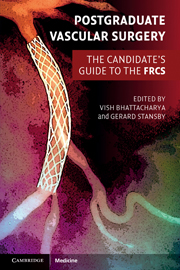Book contents
- Frontmatter
- Contents
- List of contributors
- Preface
- Section 1 Final FRCS vascular clinicals
- Section 2 Final FRCS vascular topics
- 1 Vascular risk factors and their management
- 2 Management of acute limb ischaemia
- 3 Chronic lower limb ischaemia, critical ischaemia and the diabetic foot
- 4 Endovascular and surgical options for peripheral revascularisation
- 5 Abdominal aortic aneurysms
- 6 Thoracic, thoracoabdominal and suprarenal aortic aneurysms
- 7 Aortic dissection
- 8 Popliteal artery aneurysms
- 9 Femoral artery aneurysms
- 10 Carotid, subclavian and vertebral disease
- 11 Diagnosis and management of thoracic outlet syndrome
- 12 Diagnosis and management of hyperhidrosis
- 13 Chronic mesenteric ischaemia
- 14 Acute ischaemic colitis
- 15 Vascular trauma
- 16 Indications and management of lower limb amputation
- 17 Leg swelling and lymphoedema
- 18 Varicose veins and chronic venous insufficiency
- 19 Management of deep vein thrombosis
- 20 Infection in vascular surgery
- 21 Vascular malformations
- 22 Vasospastic disorders and vasculitis
- 23 Critical care considerations and preoperative assessment for general and vascular surgery
- 24 Access surgery
- 25 Basic outline of solid organ transplantation
- Index
- References
5 - Abdominal aortic aneurysms
- Frontmatter
- Contents
- List of contributors
- Preface
- Section 1 Final FRCS vascular clinicals
- Section 2 Final FRCS vascular topics
- 1 Vascular risk factors and their management
- 2 Management of acute limb ischaemia
- 3 Chronic lower limb ischaemia, critical ischaemia and the diabetic foot
- 4 Endovascular and surgical options for peripheral revascularisation
- 5 Abdominal aortic aneurysms
- 6 Thoracic, thoracoabdominal and suprarenal aortic aneurysms
- 7 Aortic dissection
- 8 Popliteal artery aneurysms
- 9 Femoral artery aneurysms
- 10 Carotid, subclavian and vertebral disease
- 11 Diagnosis and management of thoracic outlet syndrome
- 12 Diagnosis and management of hyperhidrosis
- 13 Chronic mesenteric ischaemia
- 14 Acute ischaemic colitis
- 15 Vascular trauma
- 16 Indications and management of lower limb amputation
- 17 Leg swelling and lymphoedema
- 18 Varicose veins and chronic venous insufficiency
- 19 Management of deep vein thrombosis
- 20 Infection in vascular surgery
- 21 Vascular malformations
- 22 Vasospastic disorders and vasculitis
- 23 Critical care considerations and preoperative assessment for general and vascular surgery
- 24 Access surgery
- 25 Basic outline of solid organ transplantation
- Index
- References
Summary
Key points
An aneurysm is an abnormal focal dilatation of a vessel with a greater than 50% increase in its diameter
Elastin degradation due to matrix metalloproteinases (mainly 2.9 and 12) in the aortic media is the most significant pathology
Smoking, male gender, hypertension and genetics are the main risk factors
The annual risk of rupture between 5 and 5.9 cm is 5%
Contrast enhanced computed tomography (CT) is the gold standard for measuring size and morphology
The UK Small Aneurysm Trial (UKSAT) helped reach a consensus about the minimal size of treatment, which is 5.5 cm
The UK Endovascular Aneurysm Repair (EVAR) 1 (in fit patients) trial showed that the 30-day mortality for EVAR was 1.7% versus 4.7% for open repair, although by 4 years all-cause mortality was the same
The EVAR 2 trial (in unfit patients) showed no difference in mortality between conservative management and stenting
Fenestrated grafts allow stenting of juxtarenal aneurysms
Stenting for ruptured aortic aneurysms has shown promising results and a UK trial is currently underway
Introduction
Abdominal aortic aneurysm (AAA) was first described around AD 100 by Roman physicians. In 1923, Rudolf Matas successfully ligated the aorta of a patient with an AAA. The intervening years have seen many advances and improvements in diagnosis and treatment, however ruptured AAAs still cause around 6000 deaths in England and Wales per annum.
Definition
An aneurysm is defined as an abnormal, focal dilatation of a vessel, with greater than a 50% increase in the diameter.
- Type
- Chapter
- Information
- Postgraduate Vascular SurgeryThe Candidate's Guide to the FRCS, pp. 86 - 98Publisher: Cambridge University PressPrint publication year: 2011



